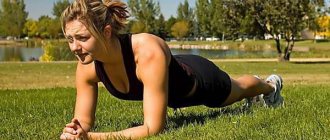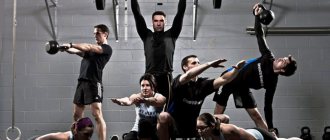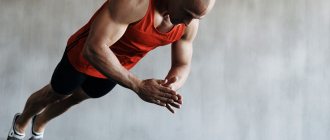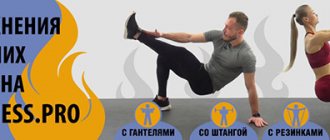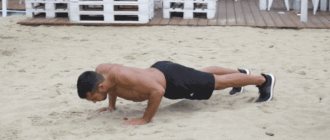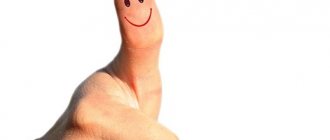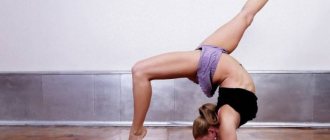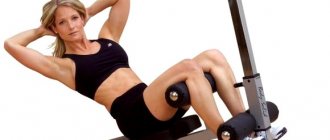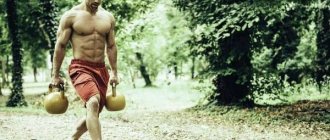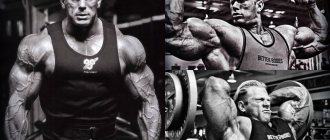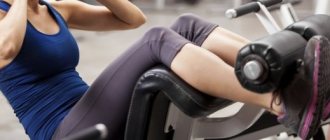The healthy lifestyle industry is moving forward with huge strides. New sports, such as CrossFit or variations of fitness, have played a significant role in this advancement. But sometimes the process of training the body reaches the absurd. In an effort to gain “functional” strength that has nothing to do with “mass,” people replace classical classes with board balance exercises. Is it worth using this “miracle” device, and, if so, how? Let's look further.
What is a balance board?
A balance board is a subtype of a balancing board. It consists of:
- boards with clamps,
- movable roller.
In some particularly advanced configurations, the roller is rigidly attached to the board using special bearings that reduce the effect of torsion and fix the amplitude of movement within one axis.
Initially, board balance exercises were intended to train coordination for athletes involved in:
- skateboarding
- surfing
- snowboarding
- ice skating
And other types of speed-strength disciplines that require additional attention to coordination.
How to cope
First of all, it is worth visiting specialists to identify the causes of the problem: for example, an ENT specialist to rule out ear pathologies. Consultations with a neurologist, traumatologist, ophthalmologist and other highly specialized specialists may also be indicated. If deviations are found in their part, we have to deal with them.
In addition, doctors recommend using various balance exercises that will help you maintain balance. Moreover, there are a lot of exercise options, but it’s difficult to single out any that are particularly important, since many show their high effectiveness. Studies conducted by various scientists have shown that performing gymnastics helps improve coordination in older people, and in a fairly serious age group (60-80 years).
The therapy program includes exercises based on squats, heel and calf raises, and one-legged balance practice. It is these types of exercises, according to foreign doctors, that not only help improve physical activity, but also train a person’s cognitive abilities, which are required to improve balance.
Article on the topic
Physical education by age. When and how much to study?
Do you need equipment for serious training?
Today, the balance board has acquired a second life; it is being actively used in crossfit and sometimes in fitness. There are several reasons for this:
- With this tool you can hone the perfect technique for performing difficult exercises.
- The balance board perfectly develops the internal abdominal muscles.
- Helps to engage small stabilizer muscles that do not take part when performing basic multi-joint complexes.
But, despite all the above advantages, exercises with a balance board are not intended for home use, or even for novice athletes. The question arises: is the use of such a complex simulator in regular training justified? This is a double-edged sword issue.
- The balance board limits the working weights. Because of this, the effectiveness of training complexes decreases significantly.
- Strict requirements for exercise technique are needed to minimize the possibility of injury.
- There is a risk of injury even with perfect coordination.
Among other things, using a balance board for purposes other than its intended purpose often leads to micro-tears of muscles and injuries to ligaments and tendons.
How to structure your workouts
*If you only train with this equipment, do it 2-3 times a week. If you combine it with other strength and cardio training - 1-2 times.
* Perform each exercise 10-12 times, doing 1-4 approaches or cycles in circuit training mode. How much exactly - decide based on your level of physical fitness. The load should be such that the last three repetitions of the exercise are difficult, but without violating the technique.
* For BOSU training, wear sneakers that provide good ankle support and minimal slipping.
*If you have never used this machine before, start with the simplest exercises and do them slowly. At first, don’t turn BOSU “upside down”: it’s harder to resist.
Basics of training on a balance board
Exercises on a round balance board or other board variations require special attention to many factors that beginners do not pay attention to.
First of all, you need to master the basic movements of the balancing board itself. This can take up to a month of training, when the athlete learns to stand and maintain balance without performing separate training complexes.
Secondly, the need for good exercise technique without using a board. Thus, only by being able to feel and distribute the load in different muscle groups during an approach can you move on to complex variations while supporting your own balance. In particular, squats with dumbbells/barbell are not recommended due to the special type of axial loads that are determined by the pressure of the heels and the possibility of uneven weight distribution during the approach.
At the same time, the balance board is extremely effective in cases where you need to work the muscles from different angles. For example, there are dozens of types of dynamic push-ups that can reduce the load on the triceps and deltoids, focusing on all three bundles of the pectoral muscles, which is important for workout athletes whose upper chest lags behind the lower.
The balance board is not used on the day of the main training with weights, since performing exercises and putting stress on the stabilizer muscles reduces the effectiveness of the basic complexes and increases the risk of injury. In the case of CrossFit programs, the board helps increase the effectiveness of thrusters and other jerking exercises.
The most effective equipment for training
Balance training takes place both in group classes and individually. Having learned the basics of this workout, you can practice even at home, having previously purchased the necessary equipment.
Gymnastic ball and gymnastic hemisphere
Gymnastic ball
and its “derivative” in the form of a gymnastic hemisphere are ideal for balance training.
With the help of a gymnastic ball you can train your arms, legs, and abs. With the help of a gymnastic ball you can train your arms, legs, and abs. The best option for these purposes is the REEBOK gymnastic ball ( RSB-16016
).
The gymnastic hemisphere gives more freedom of action, allowing you to work out almost all muscle groups. Due to the fact that the equipment has a flat surface, the number of exercises performed increases, but the effectiveness of the training does not decrease. Training with kettlebells
is close in effectiveness , but in the latter case you will have to lift heavy weights, which is not accessible to everyone.
The peculiarity of training with a gymnastic hemisphere is the following: when the dome of the ball is facing upward, you can perform exercises on an unstable surface, while the machine itself remains motionless. This allows a wide range of people to engage in the gymnastic hemisphere (children, elderly people, athletes with injuries).
INTERESTING! The gymnastic hemisphere (BOSU ball) was invented back in 1999, but began to be actively used only in 2015.
Balance pad
An effective accessory for balance training, suitable for beginners. The balance pad is 90% filled with air, so it feels like you are in zero gravity. The accessory takes up little space and allows you to perform many types of exercises.
Core board
The core platform is a modified version of the step platform that was developed by Reebok physical therapists. It does not have a stable position and is like a fitball. The name comes from English. the word “core”, which means “core”.
The simulator consists of two oval boards and a stand, which does not allow the boards to fix their position, but makes it possible to change the angle of inclination. Thanks to this feature, the oblique muscles of the body are well worked out. A good choice would be the RSP-16160
.
You can get a detailed description of these balance training machines and find out prices in our FitnessVam online store.
Basic exercises for board balance
The balance board is a universal exercise machine that allows you to carry out absolutely any type of movement. But not all training complexes will be equally effective for athletes not involved in snowboarding or surfing. For the average fitness club visitor, the following board balance exercises are recommended:
- front squat,
- squats in a longitudinal position,
- twisting,
- thrusters,
- medicine ball throws,
- bar,
- raising dumbbells to the sides,
- lifts in front of you,
- tilt wiring,
- pulling weight to the chin,
- lunges,
- push ups,
- bent over row.
The editors of the portal recommend that athletes pay special attention to exercises with their own weight and try to avoid exercises that involve a change in the center of gravity.
Why is balance needed?
Experts note that a sense of balance helps a person maintain his center of gravity while walking, standing, jumping, running, bending, twisting and other active movements. In fact, people usually take the ability to walk straight and stand without falling over as a given, without thinking about how complex this system is.
Every time a person makes any movement, his brain and eyes process a huge amount of information about what is happening around him. The legs can sense changes in terrain, such as whether the surface you are walking on is flat or bumpy, on asphalt or dirt, etc. The arms swing at a certain pace and rhythm to help maintain stability, the muscles and joints provide a certain strength, which allows you to move forward, stop if necessary and change direction.
However, this system may not function properly, for example due to injury. It also naturally gets worse over time. As we age, information travels from the body to the brain at a slightly slower rate. Muscles lose elasticity and strength, joints remain without their inherent flexibility.
Particular attention should be paid to the inner ear, which is similar to a labyrinth in its structure. It is often called one of the main organs that allows you to maintain balance. Therefore, doctors often say that the balance is disturbed precisely because of problems with the middle ear in the following cases:
- Otitis interna, which is an infectious inflammatory disease of the inner ear, leading to dizziness and balance problems;
- Meniere's disease is a pathology that manifests itself as dizziness, noise in one ear, hearing problems, nausea and vomiting.
Balance may also be noticeably worse due to hearing loss or even ear congestion.
If your head is spinning. Sudden loss of balance is a dangerous symptom Read more
Anatomical map of the complexes
Let us consider the main exercises presented in order to describe their capabilities for developing the functional strength of an athlete.
| Exercise | Type | Efficiency of board balance | Target muscle group | Danger when performing |
| Front squats | Basic | High | Gluteal muscles + core stabilizer muscles | Average |
| Longitudinal squats | Basic | Average | Working out the quadriceps and lateral abdominal muscles | Average |
| Crunches | Insulating | Low | Abdominal muscles and core | Absent |
| Thrusters | Complex | High | Upper shoulder girdle | High |
| Medicine Ball Throws | Aerobic | High | Upper shoulder girdle | Moderate |
| Plank | Complex | High | Abdominal muscles and core | Absent |
| Dumbbell lateral raises | Insulating | Low | Upper deltas | High |
| Front dumbbell raises | Insulating | Low | Front delts | High |
| Tilt wiring | Insulating | Low | Rear delts | Very high |
| Barbell row to the chin | Insulating | Low | trapezoids | Moderate |
| Lunges | Basic | High | Gluteal muscles + core stabilizer muscles | Absent |
| Push ups | Basic | High | Abdominal muscles and core | Absent |
| Bent-over weight row | Basic | Low | Back muscles (latissimus + rhomboid + trapezius) | Extremely high |
As can be seen from the table data, despite the high efficiency of the balance board when performing some exercises, combining it with lifting heavy weights is ineffective and very dangerous. The best development is provided by exercises that require removing the body from balance and maximum amplitude (squats, push-ups).
Squats
Perhaps the main justified exercise with a balanced board is squats. There are three main types:
- Front plank squats. They allow you to concentrate the load on the inner surface of the thigh groups, creating accentuated stabilization on the oblique and lateral abdominal muscles.
- Cross board squats. Develops the abdominal/lower back ligament. Relieves the load on the quadriceps and works the soleus muscles.
- Squats on a round board. Allows you to achieve the highest control over all the muscles that hold the body in an upright state.
Note: This is purely about unweighted squats. The barbell on the shoulders/chest changes the athlete’s center of gravity, which negatively affects the spine and joints!
In the front post
How to properly perform front squats:
- Stand on the balance board. Hold your heels as firmly as possible.
- Keeping a perfectly straight spine, slowly squat down without allowing the board to deviate.
- You should not linger at the bottom point and create an impulse push. The lift is carried out as smoothly as possible while maintaining balance.
In the longitudinal rack
The longitudinal stance exercise is not much different.
- Stand on the balance board.
- Secure the body using the calf/lower back/abs ligament.
- Holding the fixed position, squat down with the buttocks pulled back as far as possible.
- You shouldn’t linger at the bottom point and create an impulsive push. The lift is carried out as smoothly as possible while maintaining balance.
Balance gymnastics on the ball
Gymnastics on a special fitball is a modern therapy technique suitable for patients of any age. This method has the following effects:
- muscles become toned without putting excessive strain on the back;
- light stretching of all muscle groups is performed;
- the spine is stretched (especially useful for people suffering from osteochondrosis);
- intestinal motility increases, the functioning of the liver, kidneys and stomach improves;
- posture is restored;
- the vestibular apparatus is formed, a sense of balance and balance develops;
- Fitball exercises also allow you to prevent osteoporosis, osteochondrosis, flat feet and muscle failure.
During exercises on a fitball, with each change of position the fulcrum changes, which causes slight vibration and, as a result, wave contractions of the muscles, which has a positive effect on the entire human body. Balance training at the Yusupov Hospital is carried out under the supervision of an instructor, who can correct and correct the patient’s movements at any time.
Ab exercises
The main abdominal exercises are rolls on a balance board. Performed as follows.
- Stand on the balance board. Hold your heels as firmly as possible.
- After this, move the body above the hip joint, slowly shift the center of gravity of the body to one side.
- The position is adjusted by changing the load in the heels.
- After rolling to one side, slowly begin moving in the opposite direction.
For the longitudinal strut everything is similar, except that:
- Fixation occurs by combining the lumbar/abs ligament.
- Rolls are carried out by changing the load by rolling from heel to toe.
Thrusters
Thrusters are one of the most difficult movements, both in the gym and on the balance board. The use of a board is justified not for achieving high results, but for creating ideal coordination. Therefore, you need to work with weights no more than 10% of the repeated maximum. The exercise technique is as follows.
- Take the weight to the starting position.
- Place your weight firmly on the balance board, using your heels as a balancer.
- The movement is not divided into phases (as in the classic push), but is performed simultaneously. Those. the push in the shoulder joint occurs simultaneously with the exit from the squat.
- The knees must be facing outward. This will avoid injury and make it easier to hold the body.
The exercise is performed with dumbbells or a trap bar. The use of a classic bar is unacceptable due to the shift in the center of gravity.
Medicine Ball Throws
The first exercise to increase interaction with the balancer. After the athlete has learned to work on the racks, you can begin to perform.
- Pick up a medicine ball.
- Throw it, keeping the angle of the throw within one axis (not obliquely).
- When catching the ball, minimize concentration on your legs.
At first, beginners often fall off the balance board due to insufficient neuromuscular connection or are unable to catch the ball because they are concentrating on maintaining balance. The exercise helps to compensate for the impulse impulse at the spinal level, which reduces the likelihood of injury in more complex and severe complexes.
Plank
The balancing board is an ideal solution for complicating the plank. It increases the load on the oblique and lateral abdominal muscles.
- Stand in a plank position, resting your elbows on the balancing (front) board.
- The center of gravity is adjusted not by the shoulder joint, but by turns and movements of the body.
- Try to avoid play in the housings, leveling out the rotating effect of the balancing board.
As a complication, you can perform a plank with rolls from one side to the other. Here you need:
- Adjust the position of the body not only with the abdominal muscles, but also with the shoulder joint.
- Maintain a parallel body position relative to the floor.
Should I hold out or not? (bent over row)
IMPORTANT! The editors of the portal strongly advise against mastering the technique of deadlifts on a balancing board. Before any lifts or exercises that seriously work your back, master perfect form with heavy weights in the gym without a board. Do not use weights when working with a balance board. Reduce the projectile by 10-20 times your 1 rep max.
Bent over rows are one of the most ineffective exercises for a balance board. But, if you decide to eliminate the possibility of injury, then before working with heavy weights, you can hone your technique on the board.
- Take dumbbells in your hands.
- Completely level the body, maintaining the deflection.
- Stand in a stance on the balance board. We keep our balance with our heels.
- Make a bend. The arching technique is similar to the Romanian deadlift – i.e. with maximum protrusion of the buttocks back. So, the center of gravity will be strictly at the center of the board - which will reduce the axial load on the spine.
- Pull the dumbbells towards your waist.
Traction is accomplished through the use of the elbow joint. The rest of the exercise is completely similar to a simple bent-over row. It is not recommended to use heavy weights, as this is not effective in terms of increasing strength and mass.
Working with deltas
Balance board – very often used when working with delta training. Everything is very simple. The need to control balance does not allow for impulse jerks, which reduces the risk of injury and increases the load on the deltoids. It is important to understand that, as in the case of the back, you need to work on the basic technique and not use heavy weights for training.
Dumbbell lateral raises
This exercise is designed to develop the middle deltoids, and is an effective analogue of the military press:
- Take dumbbells in your hands.
- Stand on the longitudinal board, maintaining balance with your heels.
- Level the body as much as possible.
- Start lifting dumbbells to the sides with straight arms.
- Having reached the point of perpendicularity of the body, hold for 1-2 seconds.
- Lower the dumbbells.
The entire exercise is performed exclusively at a slow pace, without jerking, which could disrupt balance..
Lifts in front of you
This exercise is designed to develop the anterior deltoids. May Help Develop Huge Shoulders
- Take dumbbells in your hands.
- Stand on the longitudinal board, maintaining balance with your heels.
- Perform a slight deflection with a forward tilt (no more than 15 degrees) to level out the change in the center of gravity.
- Start lifting dumbbells in front of you with straight arms.
- Having reached the point of perpendicularity of the body, hold for 1-2 seconds.
- Lower the dumbbells.
The entire exercise is performed exclusively at a slow pace, without jerking, which could disrupt balance.
Tilt wiring
Exercise for the development of the posterior deltoids. It is distinguished by extremely heavy equipment, as it combines elements of holding a similar body in deadlifts, and suppressing the jerking impulse from movement in the deltas
- Take dumbbells in your hands.
- Completely level the body, maintaining the deflection.
- Stand in a stance on the balance board. We keep our balance with our heels.
- Perform a Romanian backbend, with maximum protrusion of the buttocks back.
- Start lifting dumbbells to the sides with straight arms.
- Having reached the point of perpendicularity of the body, hold for 1-2 seconds.
- Lower the dumbbells.
Weight pull to the chin
The dumbbell and barbell row to the chin is one of the most dangerous exercises in bodybuilding. It is characterized by extremely strict technique, in return it offers an isolating, serious load on the upper trapezius. When using a balance board, the technique is similar to deadlifts with dumbbells or a trap bar. Except for the fact that it is necessary to maintain a very specific deflection angle, which is not used in the standard variation.
- Take the weight in your hands.
- Stand on the balance board.
- Bend slightly forward (more than 10-15 degrees of body deflection).
- Slowly, move the elbow joint and begin lifting the dumbbells from the sides.
- Stop at the moment when the elbow joint rises above the shoulder.
- Slowly lower the projectile.
How to develop stabilizers
There is a well-known rule that applies to almost all aspects of the physical development of the body: targeted exercises develop the corresponding parts and functions of the body.
Simply put, in order, for example, to learn pull-ups, you just need to do pull-ups and all the necessary muscles will develop. Of course, assistance exercises can be used, but targeted movements provide optimal results.
Therefore, if you want to learn how to maintain balance better, then you should simply do exercises to maintain balance. There are quite a few of them and they are well known.
- Isometric exercises. In other words, static. Planks, static half-squat, holding an incline while standing with the body half-bent and extended forward. There are a huge number of options. Wherever you need to maintain a static position and control the body, stabilizers will work.
- Hemispheres and fitballs . They sit on the hemispheres and squat, simply maintain their balance, and perform various movements. Fitballs also work great on stabilizers.
- Rotations with dumbbells and elastic bands. Most often these exercises are used for stabilizers of the shoulder girdle, of which there are quite a lot. But there are other options, for example, elastic bands are great for developing leg stabilizers.
In general, these are the groups of main target exercises. Finally, let's highlight simple yoga balances, such as cross-legged stands and poses like garudasana. They also perfectly develop balance and do not require additional equipment.
Push-ups for balance board
Push-ups, unlike various types of rows and swings, are, on the contrary, extremely effective and appropriate exercises using a balance board. In this case, you can use absolutely any variation:
- longitudinal,
- frontal,
- round.
There are several main types of push-ups that are used on a balance board:
- classic push-ups,
- grasshopper,
- push-ups with a roll on the board,
- push-ups with one hand on the board.
Let's look at the technique in groups.
Classic and grasshopper
- Place the board in front of you - at the level of placing your hands. For classic ones, in the area of the shoulders, for the grasshopper in the area of the bottom of the pectorals.
- Stand upright, lying down, hands on the board.
- Balance is maintained not by changing the pressure load of the deltas, but solely by turning the body.
- Having fixed the board in a neutral position as much as possible, do push-ups.
Everything seems simple, but holding the body and the board is the main problem in this exercise.
Rifles
In the case of rolling exercises, everything is somewhat more complicated.
- Take a lying position with your hands on the board.
- Move the board to the extreme position of the balancer, holding it parallel to the floor with the movements of the deltoids and the load of the triceps.
- Gets as close to the board as possible.
- At the exit from push-ups, use the movements of the front deltas to move the board to the other edge.
By using this method, the pecs and deltoids are worked from all angles, which increases the effectiveness and complexity of push-ups. One-arm push-ups are similar to “multi-level” push-ups. They have no special technique, other than the need to hold the hand in the correct position.
Lunges
Despite its name, this exercise cannot be called lunges in its classical sense. The correct name is a front leg squat. From the point of view of the effectiveness of muscle development and coordination, its effectiveness is maximum. The technique is quite simple:
- The feet are placed on the edges of the board lengthwise, not across.
- Balance is maintained with the entire body, without focusing on the hip joint or heel pressure.
- You need to squat so that the knee of the non-supporting leg is as close to the board as possible.
